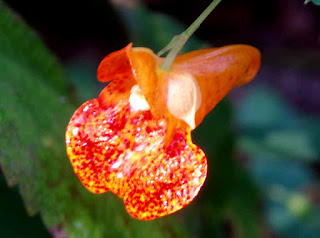Jewelweed is best
known for its skin healing properties. The leaves and the juice from the stem
of Jewelweed are used by herbalists as a treatment for poison ivy, poison oak
and other plant induced rashes, as well as many other types of dermatitis.
Jewelweed works by counter-reacting with the chemicals in other plants that
cause irritation. Poultices and salves made from Jewelweed have been and still
are a folk remedy for bruises, burns, cuts, eczema, insect bites, sores,
sprains, warts, and ringworm. Jewelweed
is a smooth leafed annual, growing 3-5 foot tall. Its leaves are oval and round-toothed with the
lower ones opposite, upper ones alternate. The flowers which are a bit trumpet shaped, hang
from the plant much as a jewel from a necklace. Pale Jewelweed has yellow flowers, spotted Jewelweed
have orange flowers with dark red dots. The
seeds will 'pop' when touched and that is where the common name name “Touch-Me-Nots”
came from. The Spotted Jewelweed variety
is most commonly used for treating poison ivy rashes although the Pale
Jewelweed has been noted to have some medicinal properties also.
Jewelweed
blooms May through October in most of the southeast. It is found most often in moist woods, usually
near poison ivy or stinging nettle. It is said that wherever you find poison
ivy, you will find Jewelweed, however this is not always true as Jewelweed will
not grow in dry places for long, and does not do well in direct sunlight. Poison Ivy will grow in sun or shade. Jewelweed often grows on the edge of creek
beds. There is plenty of jewelweed in the wild, and it is not hard to find once
you learn to identify it. I have also read
that the garden variety of impatiens may have the same properties, but not as
concentrated. However, the garden
variety is much more suitable for cultivation as its growth is easier to
contain.
When you are
in the field and find you have been exposed to poison ivy, poison oak, or stinging
nettle you can reach for the jewelweed plant and slice the stem, then rub its
juicy inside on exposed parts. This will
promptly ease irritation and usually prevents breakout for most people.
Jewelweed or an
infusion made from boiling the leaves of Impatiens may be frozen for later use.
Brew chopped spotted jewelweed in
boiling water until you get a dark orange liquid, strain the liquid, and pour
into ice trays. When you have a skin
rash, rub it with a jewelweed cube and you will be amazed with its healing
properties. It will keep in the freezer for up to a year. You can also preserve the infusion by canning
it in a pressure cooker.
Jewelweed
does not dry well however, due to its high moisture and oil content. Do not make alcoholic tinctures from Jewelweed
because some people have had a bad reaction using jewelweed with alcohol. You can also make jewelweed soap.
"The Results of
a Clinical Study, in which a 1:4 jewelweed preparation was compared with other
standard poison ivy treatments for its effectiveness. Of 115 patients treated with jewelweed, 108
responded more readily to the topical application of this medication and were
entirely relieved of their symptoms within 2 or 3 days after the institution of
treatment. It was concluded that jewelweed is an excellent substitute for ACTH
and the corticosteroids in the treatment of poison ivy dermatitis. The active
principle in jewelweed responsible for this activity remains unidentified.


